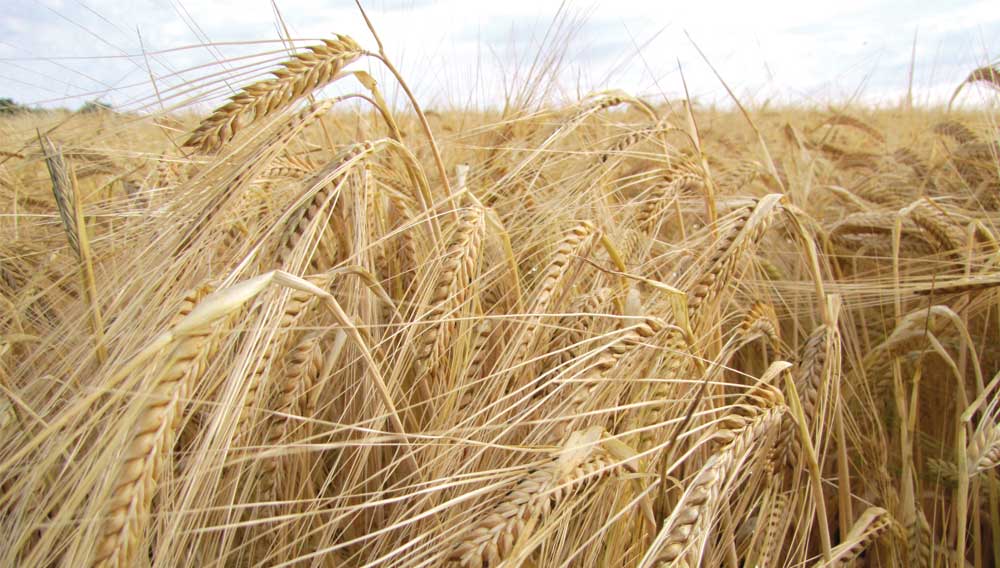Of Lost Barley and Particular Malt Varieties
Heirloom & Terroir | As part of the program surrounding this year’s BrauBeviale, RMI Analytics of Hamburg, Germany, will feature an all-day symposium about “Heirloom & Terroir Barley and Malt.” The event will take place on Monday, November 12, on the grounds of the tradeshow. In April, BRAUWELT International Editor-in-Chief Dr. Lydia Junkersfeld conducted an interview with the RMI Managing Director and event organizer, Christian Temme, and Horst Dornbusch, who will moderate the symposium in November.
What prompted you to become interested in old and historic barley and malt varieties – and why now?
Dr. Christian Temme: I find it very interesting that brewers – especially in the craft brew segment – spend endless amounts of time and effort nowadays to select their hops for bitterness, flavors, and aromas. In their quest for ever newer varieties, they now source their hops from all four corners of the globe, from New Zealand to the USA, from Alsace to Australia, and from the Hallertau in Germany to Kent in the United Kingdom. However, when it comes to the malts in their mash tuns, they seem to focus almost exclusively on generic types. They specify their grain bills in terms of Pilsner malt, Vienna malt, Munich malt, or chocolate malt, but are apparently completely unconcerned about the barley varieties that are behind them. I find this strange, because, as everybody knows, different barley varieties can play a significant role in the flavor profiles and performance characteristics of malts, which, in turn, can affect the beers made from them.
It is indeed true that most hop flavor differences come directly from the plants themselves and not from the hop processor or distributor, whose main job it is to preserve the quality of the product. In malt, by contrast, the reverse is true. It is generally accepted that the maltster is responsible for perhaps four-fifth of the product’s characteristics, which include the color, sweetness, foam stability, and aroma intensity. In malt, the barley grower plays a lesser role. Yet, the underlying barley variety influences some of the malt’s characteristics, which include its protein content, phenolics, diastatic power, and sensory balance.
Horst Dornbusch: May I add, for a brewer, the quality of the raw materials is a necessary, though not sufficient condition for making quality beer. This means that even a competent brewer will find it difficult to make a quality brew from defective raw materials, while an unskilled brewer can make an undrinkable beer even from the best raw materials. That said, with the advancements of malting technology in the last 150 years or so, most maltsters are now capable of producing fairly consistent malts at a high level of quality. This heightens the importance of the natural properties of the underlying agricultural raw materials as a differentiator for diversity in beer flavors. It all starts with the breeder, who selects the composition of a new barley variety from known genetic markers. In other words, a focus on the impact of barley varieties on malt varieties brings us inevitably to the subject of cereal genetics, not just for malting barley, but also, for instance, for brewing wheat.
But that has always been the case, hasn’t it?
Dr. Temme: Well, not necessarily. Not too long ago, when all the large breweries produced essentially just a handful of beer styles and composed these to appeal to the mass market, it seemed sufficient for breeders and growers to focus almost exclusively on a cereal’s agronomic efficiency. A variety needed to be primarily high-yielding, as well as pest- and disease-resistant. This orientation also offered enormous economic incentives. It became profitable for farmers to grow a niche product such as malting barley, in many regions, even in competition with wheat.
Dornbusch: With the structural changes in the global beer market in recent decades, however, almost 20 percent of consumers are now looking for greater diversity in beer flavors and beer experiences. This makes a reorientation by all participants in the brewing raw materials supply chain almost inevitable. This applies to the breeding business, the farming business, and the malting business. The hop supply chain has already passed through this phase and has demonstrated how successful such a development can be. In brewing cereals, this change has only just begun. Breeders must now figure out which factors produce the required variety of flavors in their raw materials so that maltsters and brewers can respond appropriately with the right portfolio of malts and beers to satisfy the wishes of their beer consumers.
Dr. Temme: Because of these new consumer expectations, everyone involved in the supply chain – from the stalk to the glass – is now under the microscope. A beer must now be traceable all the way back to the seed from which it sprang. In many instances, traceability of food items is not only a legal requirement, it is also part of a new, consumer-driven ethos that embraces such attributes as local, sustainable, and authentic.
Gentlemen, aren’t you now whistling Dixie?
Dr. Temme: Well, perhaps, to a certain extent. Look, we are not talking about a mass movement yet. However, sometimes a gentle breeze rustling the leaves of a tree is really the harbinger of a mighty storm. Recently I looked at the labels of some of the beers that had won medals at the European Beer Star. Only one in a 100 bottles listed the barley variety from which the beer was made. This was a beer by the Riegele brewery of Augsburg. It advertised that the beer was made from the barley variety Steffi®.
By contrast, more than half the labels listed the hops varieties. Often we also find hop varieties mentioned in glowing terms in beer descriptions. Sometimes the hop variety even inspires a beer’s brand name. As examples, I am thinking of “De Molen Amarillo” or “The Kernel Pale Ale Simcoe.” Barley still has some catching up to do in this department.
RMI Heirloom Malt Brewing Award
Dornbusch: However, we already see hints of a change in the offing. For instance, RMI Analytics has added a brewing contest, the “RMI Heirloom Malt Brewing Award,” to accompany the upcoming symposium in Nuremberg. It offers brewers a platform to showcase their work with historical malts. The response to the contest proves to us that there is an emerging interest in heirloom and terroir malts in many parts of the world.
Dr. Temme: Exactly. We received 28 entries from nine countries; and many are truly interesting. Recipes from several countries feature Chevallier, for instance, which is a barley variety with deep roots in British landraces. Another exciting variety in several recipes is Barke®, a genetic descendant of a Moravian landrace which was used in the first Pilsner. We are also very happy about the support and sponsorship of the competition by Saatgut Breun, a Bavarian barley breeder.
This brings us back to the symposium.
Dr. Temme: Yes, we have been able to engage 17 top experts from six countries for the symposium. They will tell us how all the stakeholders in the supply chain respond to the new consumer landscape.
I assume it starts with the breeder?
Dornbusch: Yes, until just a few decades ago, all breeding involved merely selections of individual plants or crossings of two individuals. But today, we use the tools of genetics to identify markers in a plant’s DNA for certain characteristics and then integrate these in almost infinite permutations of new varieties. Because of new consumer expectations, it is now important for breeders not only to select markers for agronomic properties, but also for diverse beer flavors. Luckily that is possible today. Especially the mating of genetic characteristics from various pure landraces shows great promise. Landraces have a long history. They have developed autonomously, over millennia, in different climates, and under different growth conditions. To combine their traits at will was simply impossible until very recently. For instance, it is just not probable in nature that a Scottish landrace would cross itself with a Bohemian landrace, but today such a crossing can occur with human help.
Dr. Temme: What we are talking about is not just the potential that resides in the genetic heritage of landraces, that is, their heirloom component. We are also considering their flavors, which they have developed in response to specific soil conditions, topographies, climates, and other environmental factors. In short, we are also talking about biodiversity as a result of different terroirs.
Dornbusch: The core driver behind these developments is the need to fulfill consumer demands. There is now a growing awareness that the properties of the raw materials that farmers hand over to the processors play a significant role in shaping the end product. And our symposium is precisely about this new trend.
Dr. Temme: For example, at the symposium, an entire cadre of experts from the area around Norwich, in Norfolk, UK, will give a set of presentations about the almost lost barley variety, Chevallier, which we mentioned earlier. That variety was discovered by chance by a clergyman, in 1820, and within seven decades, it had become an ingredient in virtually every ale produced in Britain. In addition, it became one of the most widely planted varieties of barley in the world, from New Zealand to Canada to Central Europe. After World War I, however, it suddenly disappeared, as it was being replaced by agronomically more advantageous varieties. Only a few grains remained, which a seed bank at the John Innes Center, in Norwich, kept viable. Enter the Crisp Malting Company, in Fakenham, in Norfolk, which just a few years ago decided to revive this variety commercially and have it cultivated by a group of contract farmers in spite its low yield. The reason: Chevallier epitomizes the typical British ale flavor like no other variety.
There are similar moves afoot to revive descendants of the historical Haná agro-eco type, a Moravian Pilsner barley, whose genes are now part of almost all barley varieties cultivated around the world. This development is currently in full swing and will bring us many more surprises in the future. By the way, in Scandinavia, too, there are old barley races whose genes are contributing to such terroir beers as the Swedish Gotlandsdricka from Visby, or the Sahti from Finland. We are fortunate to have Johan Spendrup from Gotland on the podium, who will tell us about the special processing characteristics of this particular malt.
Dornbusch: We could spend hours talking about each item on the symposium agenda, but we do not want to usurp too many of the pages of BRAUWELT International.
Yes, you are right. We do not want to give away too much in advance, but keep the excitement going. This brings me to my final question. How did RMI come up with this topic and how did you link up with Horst?
Dr. Temme: It may not be well known, but RMI Analytics has a more than two decades long track record in communicating brewery raw materials issues. Market reports, barley field trips, and our bi-annual “World Barley, Malt and Beer Conference” are firmly established in the industry. Admittedly, the international grain market and the trade chain are the main focus of our reports and analyses. However, we have also made it our mission, right from the start, to provide a platform for knowledge transfer and for addressing issues of importance to the industry.
This objective has never changed, but we adapt to the times as we face new challenges, new target groups, and new communication channels. Thus, we adjust our events to modern formats. For us, the BrauBeviale family is a great role model with its courage for new formats and new target groups. We are glad that the BrauBeviale supports the symposium as a sponsor and that we are able to hold it as part of the BrauBeviale program.
We are always looking for new ideas, different perspectives, international impulses, and expertise. This is how we discovered Horst Dornbusch and were able to recruit him as a moderator for the symposium. He is both an expert in his own right and he is fluently bilingual, which makes him excellently suited for the task.
Dornbusch: I believe we have found a fruitful symbiosis that will allow us to communicate many future-oriented topics effectively.
Dr. Temme: In fact, we have already tossed around a few ideas for a follow-up event in 2020 about another exciting topic. But let’s first have a successful symposium on “Heirloom and Terroir Barley and Malt,” on November 12th.
Gentlemen, all this sounds very interesting and exciting; and BRAUWELT International is pleased to be a sponsor of the symposium. Thank you for the interview.
To learn more about the symposium, visit www.rmi-analytics.com.
Authors
Lydia Junkersfeld
Source
BRAUWELT International 4, 2018, page 284-286





